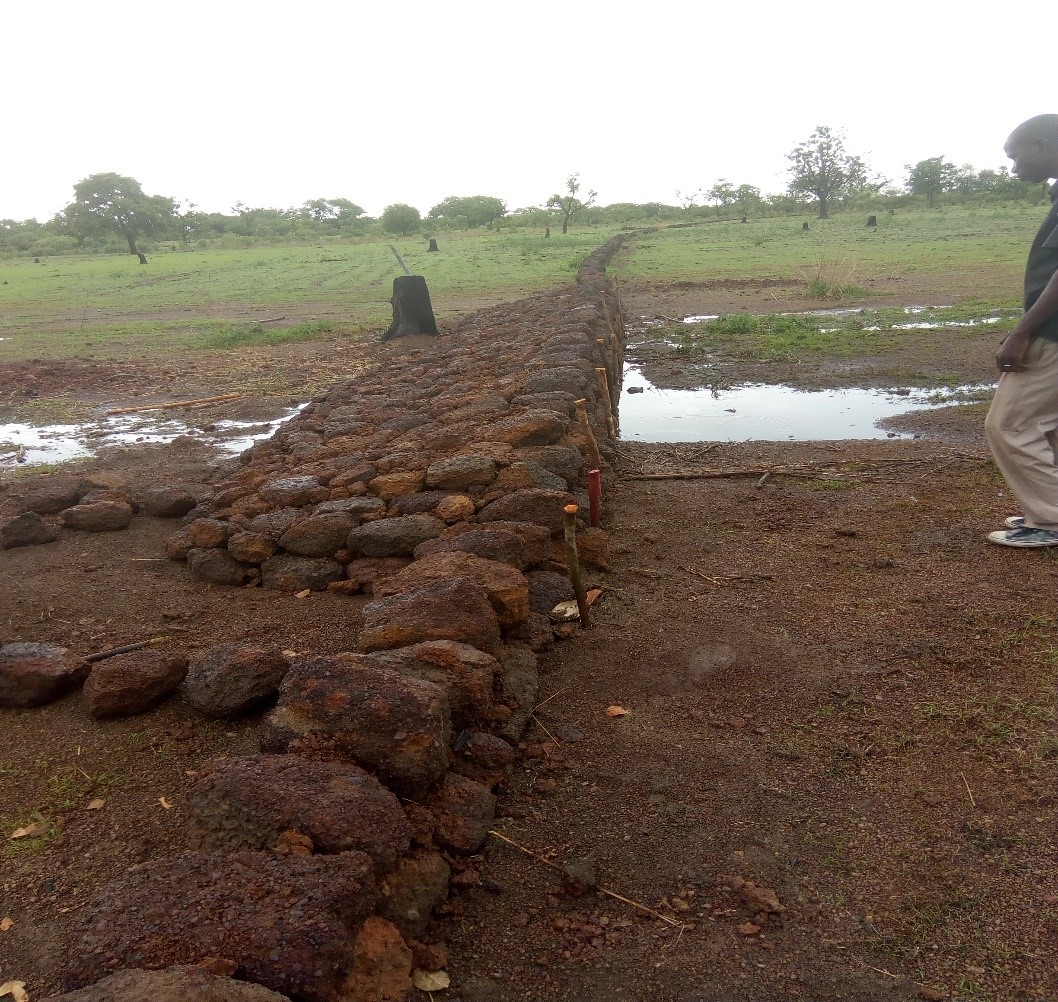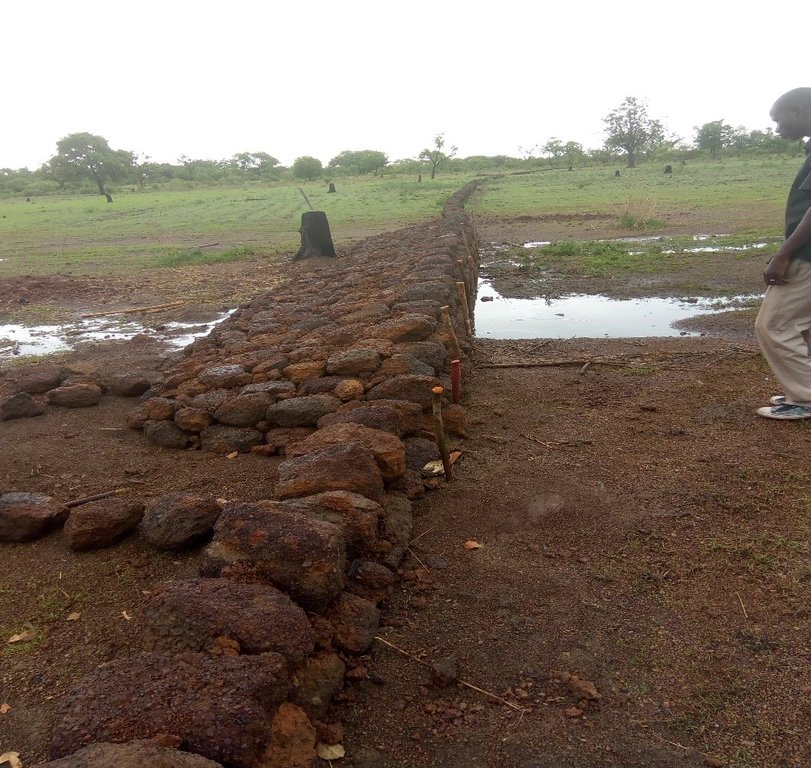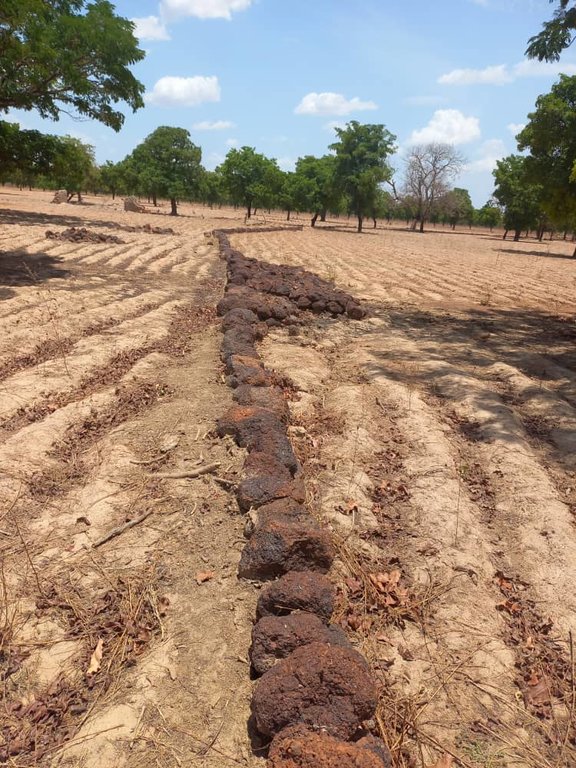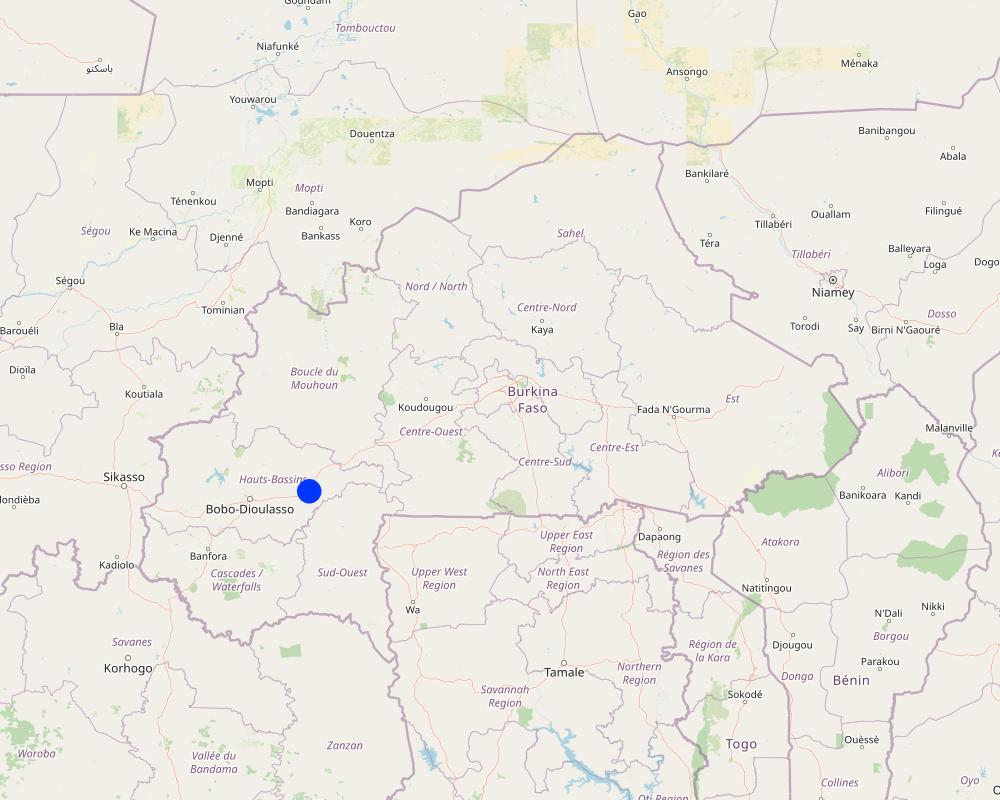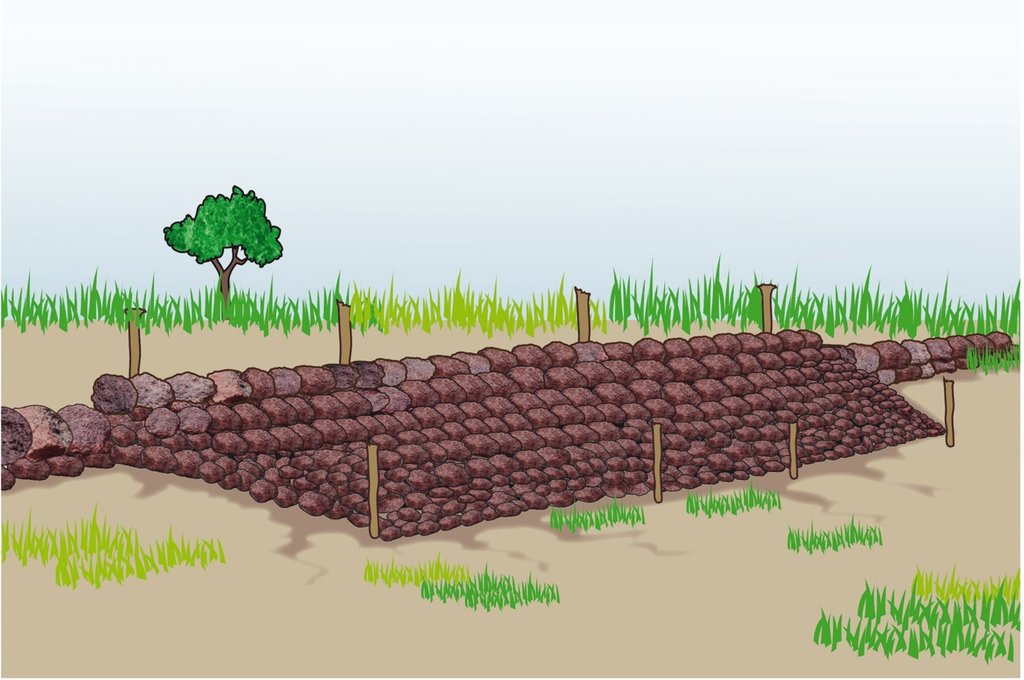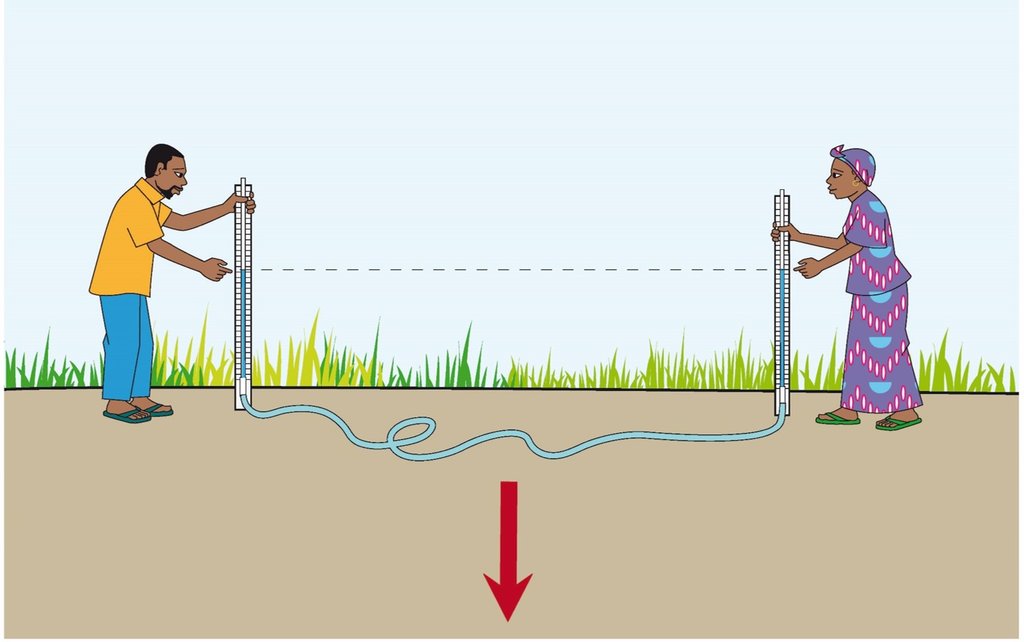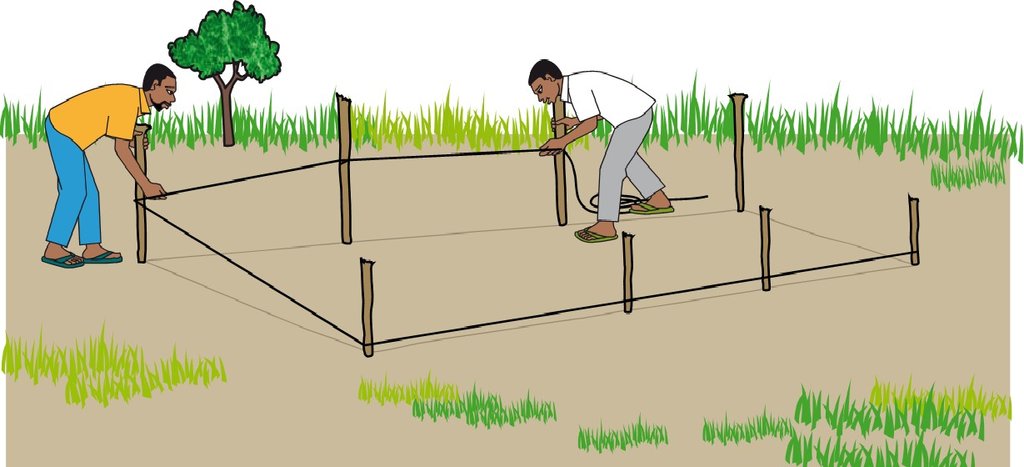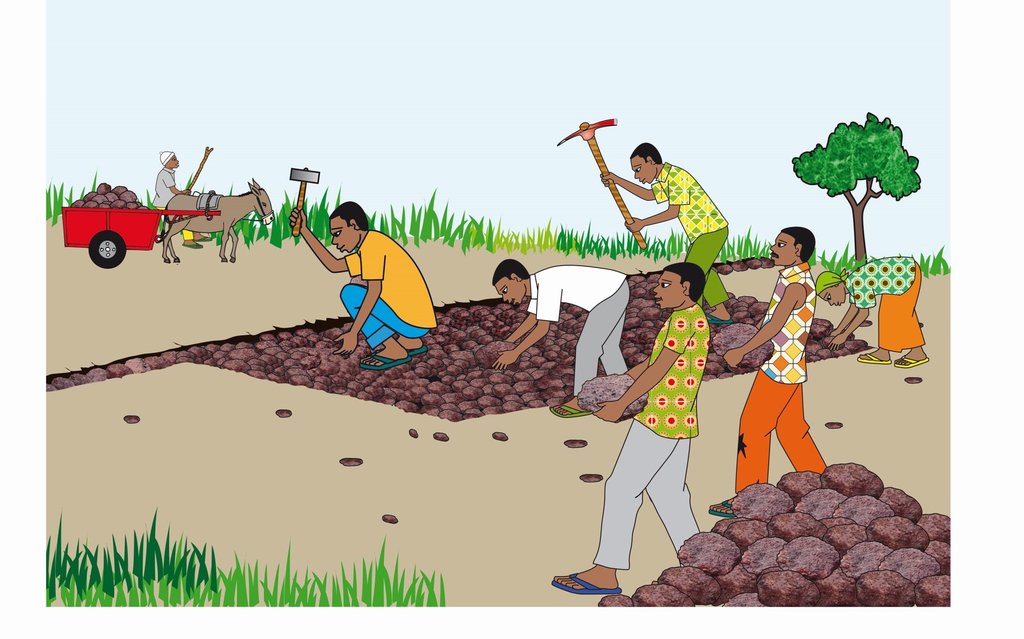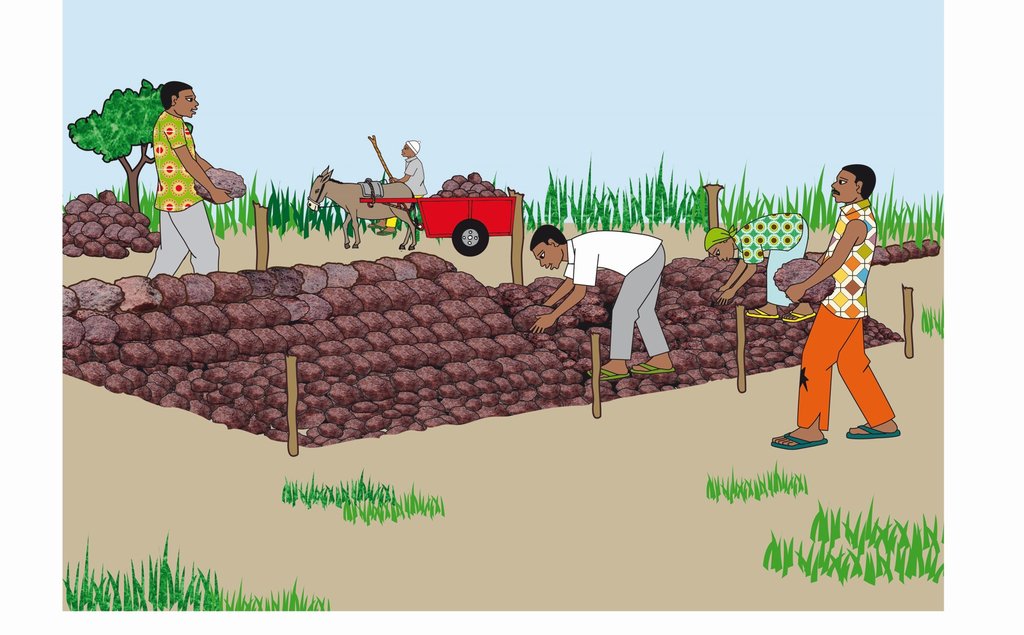Filtering dyke [Burkina Faso]
- Creation:
- Update:
- Compiler: Moussa ABOU
- Editors: Siagbé Golli, Brice Sosthène BAYALA, Tabitha Nekesa, Ahmadou Gaye
- Reviewers: Sally Bunning, Rima Mekdaschi Studer, William Critchley
Kabakourou Walandéni (Dioula)
technologies_6691 - Burkina Faso
View sections
Expand all Collapse all1. General information
1.2 Contact details of resource persons and institutions involved in the assessment and documentation of the Technology
Key resource person(s)
land user:
BONKIAN Souleymane
Burkina Faso
land user:
MILLOGO Issouf
Burkina Faso
Name of project which facilitated the documentation/ evaluation of the Technology (if relevant)
Soil protection and rehabilitation for food security (ProSo(i)l)Name of the institution(s) which facilitated the documentation/ evaluation of the Technology (if relevant)
Deutsche Gesellschaft für Internationale Zusammenarbeit (GIZ)1.3 Conditions regarding the use of data documented through WOCAT
The compiler and key resource person(s) accept the conditions regarding the use of data documented through WOCAT:
Yes
1.4 Declaration on sustainability of the described Technology
Is the Technology described here problematic with regard to land degradation, so that it cannot be declared a sustainable land management technology?
No
2. Description of the SLM Technology
2.1 Short description of the Technology
Definition of the Technology:
A filtering dyke is a water and soil conservation technology built into a temporary stream, valley bottom or a drainage channel. It is built using stones of varying sizes.
2.2 Detailed description of the Technology
Description:
A filtering dyke is a stone bund built across a gully in eroded soil, in valleys or drainage channels/small seasonal/temporary streams, in Sahelian and South Sudanese climates with average annual rainfall ranging from 400 to 1100 mm.
The structure is built on a contour line in order to reduce runoff velocity and erosive energy. It comprises stones and rubble in a bund measuring 50 cm in height and 150 cm in width. The dyke contributes to sedimentation upstream, thereby reducing the slope and enhancing surface water infiltration into the soil. Tillage should be avoided to create a stable pathway for runoff water, which may also be vegetated with perennial grasses for gully/watercourse stabilization.
Typically, the spacing between dikes along a watercourse or gully is 20 m. The key steps involved in constructing a filtering dyke are as follows:
* Siting:
•Determine a contour line using a water tube level;
•Mark the contour using tools like a daba, a pick, a pickaxe, IR12 cattle-drawn tine, tractor, stake, etc. ;
•Smoothen the contour line, if necessary, to reduce irregularities;
•Tie a string across the gully at the location chosen during technical identification of the site;
•Place stakes on both banks, notching them at a height of 50 cm to indicate the bund's design height.
* Clearing the foundation trench:
•Clean the designated area on the ground;
•Open a 20 cm-deep anchoring trench along the marked-out rope, disposing of the soil downstream of the bund.
* Design of structure with respect to water flow
* Laying the rubble and stones:
•Fill the excavated soil with gravel to around 20 cm depth.
•Place large stones upstream, followed by medium-sized stones in subsequent rows, moving downstream.
•Fill any gaps;
•Lay a second layer of loose stones, with an upstream slope of 1/1 (vertical) and a downstream slope of 1/2, until the desired height of 50 cm is reached;
•Build the edge of the structure with large stones for stabilization, deposited in an open trench downstream.
In an agricultural area, this technology must be accompanied by contour ploughing (perpendicular to the slope), to reduce the risk of erosion and accelerated runoff.
The benefits of filtering bunds include runoff control, erosion reduction, enhanced infiltration, soil moisture conservation, groundwater recharge contribution, and increased water storage in the soil. They combat land degradation by enhancing upstream water infiltration and sedimentation of sand, clay, and organic debris. Water conservation and the retention of fertile sediments by the bunds facilitate the development of natural vegetation alongside the structures, thereby restoring biodiversity and protecting structures. Although implementation may pose challenges for landowners, they recognize its effectiveness in combating water erosion and conserving soil and water resources.
2.3 Photos of the Technology
2.5 Country/ region/ locations where the Technology has been applied and which are covered by this assessment
Country:
Burkina Faso
Region/ State/ Province:
Hauts-Bassins, Houet Province
Further specification of location:
Sébédougou (Commune of Koumbia)
Specify the spread of the Technology:
- applied at specific points/ concentrated on a small area
Is/are the technology site(s) located in a permanently protected area?
No
Comments:
The technology is implemented at the scale of a micro-catchment .
Map
×2.6 Date of implementation
Indicate year of implementation:
2020
2.7 Introduction of the Technology
Specify how the Technology was introduced:
- through projects/ external interventions
Comments (type of project, etc.):
The specific technology was introduced by ProSoil, but similar structures have been built in Burkina Faso since the 1980s.
3. Classification of the SLM Technology
3.1 Main purpose(s) of the Technology
- improve production
- reduce, prevent, restore land degradation
- protect a watershed/ downstream areas – in combination with other Technologies
3.2 Current land use type(s) where the Technology is applied
Land use mixed within the same land unit:
Yes
Specify mixed land use (crops/ grazing/ trees):
- Agroforestry

Cropland
- Annual cropping
Annual cropping - Specify crops:
- cereals - maize
- cereals - millet
- fibre crops - cotton
Number of growing seasons per year:
- 1
Is intercropping practiced?
No
Is crop rotation practiced?
Yes
If yes, specify:
Cotton, maize, millet
3.3 Has land use changed due to the implementation of the Technology?
Has land use changed due to the implementation of the Technology?
- No (Continue with question 3.4)
3.4 Water supply
Water supply for the land on which the Technology is applied:
- rainfed
3.5 SLM group to which the Technology belongs
- cross-slope measure
3.6 SLM measures comprising the Technology

structural measures
- S2: Bunds, banks
3.7 Main types of land degradation addressed by the Technology

soil erosion by water
- Wt: loss of topsoil/ surface erosion
- Wg: gully erosion/ gullying
3.8 Prevention, reduction, or restoration of land degradation
Specify the goal of the Technology with regard to land degradation:
- reduce land degradation
- restore/ rehabilitate severely degraded land
4. Technical specifications, implementation activities, inputs, and costs
4.1 Technical drawing of the Technology
Technical specifications (related to technical drawing):
• Determination of a contour line using a water level;
• Transferring 03 times the height of 50 cm onto the stakes downstream of the original stake to determine the right-of-way ("apron") of the embankment, which will be 150 cm.
• Fixation of stakes downstream, opposite each projection, but this time graduated at 20 cm for slope determination;
• Opening of an anchoring trench 20 cm deep across the entire delimited area marked by the rope, making sure to dispose of the soil downstream of the bund;
• Placement of stones.
Author:
ProSoil
Date:
2021
Technical specifications (related to technical drawing):
Determination of contour lines
Author:
ProSoil
Date:
2021
Technical specifications (related to technical drawing):
Installation of the filter bund
Author:
ProSoil
Date:
2021
Technical specifications (related to technical drawing):
Filter bund anchoring trench lead time
Author:
ProSoil
Date:
2021
Technical specifications (related to technical drawing):
Installation of the filter mat for the filter bund
Author:
ProSol
Date:
2021
Technical specifications (related to technical drawing):
Construction with stones
Author:
ProSoil
Date:
2021
4.2 General information regarding the calculation of inputs and costs
Specify how costs and inputs were calculated:
- per Technology unit
Specify unit:
Linear meter
If relevant, indicate exchange rate from USD to local currency (e.g. 1 USD = 79.9 Brazilian Real): 1 USD =:
613.5
Indicate average wage cost of hired labour per day:
4333.67 FCFA/linear meter
4.3 Establishment activities
| Activity | Timing (season) | |
|---|---|---|
| 1. | Surveying | Dry season |
| 2. | Determination of the spillway ("right of way") | Dry season |
| 3. | Anchor trench excavation | Dry season |
| 4. | Installation of rubble stones | Dry season |
4.4 Costs and inputs needed for establishment
| Specify input | Unit | Quantity | Costs per Unit | Total costs per input | % of costs borne by land users | |
|---|---|---|---|---|---|---|
| Labour | Surveying | Lm | 1.0 | 166.67 | 166.67 | |
| Labour | Trench opening and construction | Lm | 1.0 | 4166.67 | 4166.67 | |
| Equipment | Cost of small equipment | Lm | 1.0 | 833.33 | 833.33 | |
| Construction material | Purchase of loose stones | Lm | 1.0 | 10000.0 | 10000.0 | |
| Other | Monitoring costs | Lm | 1.0 | 555.56 | 555.56 | |
| Other | Coordination costs | Lm | 1.0 | 277.78 | 277.78 | |
| Total costs for establishment of the Technology | 16000.01 | |||||
| Total costs for establishment of the Technology in USD | 26.08 | |||||
4.5 Maintenance/ recurrent activities
| Activity | Timing/ frequency | |
|---|---|---|
| 1. | Maintenance of the dyke | Before the rainy season |
Comments:
To be durable, erosion control structures need maintenance. It is therefore necessary to educate the population about the need to plough parallel to the contour lines, to isolate the structures by 0.5 m on either side, and to organize maintenance and repair work at the start of each campaign. This maintenance and repair work consists of replacing stones that have been displaced by human or animal intervention.
4.6 Costs and inputs needed for maintenance/ recurrent activities (per year)
| Specify input | Unit | Quantity | Costs per Unit | Total costs per input | % of costs borne by land users | |
|---|---|---|---|---|---|---|
| Other | Maintenance and repair of the dyke | Lm | 1.0 | 555.56 | 555.56 | 100.0 |
| Total costs for maintenance of the Technology | 555.56 | |||||
| Total costs for maintenance of the Technology in USD | 0.91 | |||||
Comments:
Maintaining the technology involves replacing stones that have been displaced by humans or animals.
4.7 Most important factors affecting the costs
Describe the most determinate factors affecting the costs:
The most important factors affecting costs are proximity to loose stone and labour availability.
5. Natural and human environment
5.1 Climate
Annual rainfall
- < 250 mm
- 251-500 mm
- 501-750 mm
- 751-1,000 mm
- 1,001-1,500 mm
- 1,501-2,000 mm
- 2,001-3,000 mm
- 3,001-4,000 mm
- > 4,000 mm
Specify average annual rainfall (if known), in mm:
900.00
Specifications/ comments on rainfall:
The Hauts Bassins region, where the village of Sébédougou (commune of Koumbia) is located, experiences a North Sudanese and South Sudanese tropical climate. This climate is characterized by two (02) main seasons: a wet season lasting 06 to 07 months (May to October/November) and a dry season lasting 05 to 06 months (November/December to April). Annual rainfall is relatively abundant, ranging from 800 to 1,200 mm
Indicate the name of the reference meteorological station considered:
Koumbia Rainfall Station
Agro-climatic zone
- sub-humid
Average temperatures vary between 24°c and 30°c, with a relatively small temperature range of 5°c.
5.2 Topography
Slopes on average:
- flat (0-2%)
- gentle (3-5%)
- moderate (6-10%)
- rolling (11-15%)
- hilly (16-30%)
- steep (31-60%)
- very steep (>60%)
Landforms:
- plateau/plains
- ridges
- mountain slopes
- hill slopes
- footslopes
- valley floors
Altitudinal zone:
- 0-100 m a.s.l.
- 101-500 m a.s.l.
- 501-1,000 m a.s.l.
- 1,001-1,500 m a.s.l.
- 1,501-2,000 m a.s.l.
- 2,001-2,500 m a.s.l.
- 2,501-3,000 m a.s.l.
- 3,001-4,000 m a.s.l.
- > 4,000 m a.s.l.
Indicate if the Technology is specifically applied in:
- convex situations
Comments and further specifications on topography:
The site under consideration is located at an altitude of 324 m.
5.3 Soils
Soil depth on average:
- very shallow (0-20 cm)
- shallow (21-50 cm)
- moderately deep (51-80 cm)
- deep (81-120 cm)
- very deep (> 120 cm)
Soil texture (topsoil):
- coarse/ light (sandy)
- fine/ heavy (clay)
Soil texture (> 20 cm below surface):
- coarse/ light (sandy)
- fine/ heavy (clay)
Topsoil organic matter:
- medium (1-3%)
If available, attach full soil description or specify the available information, e.g. soil type, soil PH/ acidity, Cation Exchange Capacity, nitrogen, salinity etc.
The soils are predominantly leached tropical ferruginous soils with varying degrees of sandiness in the uplands and clay soils with differing levels of hydromorphy (waterlogging) in the lowlands
5.4 Water availability and quality
Ground water table:
5-50 m
Availability of surface water:
good
Water quality (untreated):
poor drinking water (treatment required)
Water quality refers to:
both ground and surface water
Is water salinity a problem?
No
Is flooding of the area occurring?
No
5.5 Biodiversity
Species diversity:
- medium
Habitat diversity:
- medium
5.6 Characteristics of land users applying the Technology
Sedentary or nomadic:
- Sedentary
Market orientation of production system:
- mixed (subsistence/ commercial)
Off-farm income:
- less than 10% of all income
Relative level of wealth:
- average
Individuals or groups:
- individual/ household
Level of mechanization:
- animal traction
Gender:
- men
Age of land users:
- middle-aged
5.7 Average area of land used by land users applying the Technology
- < 0.5 ha
- 0.5-1 ha
- 1-2 ha
- 2-5 ha
- 5-15 ha
- 15-50 ha
- 50-100 ha
- 100-500 ha
- 500-1,000 ha
- 1,000-10,000 ha
- > 10,000 ha
Is this considered small-, medium- or large-scale (referring to local context)?
- medium-scale
5.8 Land ownership, land use rights, and water use rights
Land ownership:
- individual, not titled
Land use rights:
- open access (unorganized)
Water use rights:
- communal (organized)
Are land use rights based on a traditional legal system?
Yes
Specify:
Due to the sacred nature of the land, custom dictates that its management must not be subject to speculation.
Comments:
Based on information gathered from both literature and interviews, it appears that land access in the village of Sébédougou is mainly through inheritance and borrowing. The other modes of access (lending, leasing and buying) do not appear to be common practice, nor a perceptible reality.
5.9 Access to services and infrastructure
health:
- poor
- moderate
- good
education:
- poor
- moderate
- good
technical assistance:
- poor
- moderate
- good
employment (e.g. off-farm):
- poor
- moderate
- good
markets:
- poor
- moderate
- good
energy:
- poor
- moderate
- good
roads and transport:
- poor
- moderate
- good
drinking water and sanitation:
- poor
- moderate
- good
financial services:
- poor
- moderate
- good
6. Impacts and concluding statements
6.1 On-site impacts the Technology has shown
Socio-economic impacts
Production
crop production
crop quality
Income and costs
expenses on agricultural inputs
farm income
Socio-cultural impacts
food security/ self-sufficiency
health situation
SLM/ land degradation knowledge
Ecological impacts
Water cycle/ runoff
surface runoff
groundwater table/ aquifer
Soil
soil moisture
soil cover
soil loss
soil organic matter/ below ground C
Biodiversity: vegetation, animals
Vegetation cover
Climate and disaster risk reduction
flood impacts
drought impacts
6.2 Off-site impacts the Technology has shown
water availability
downstream flooding
6.3 Exposure and sensitivity of the Technology to gradual climate change and climate-related extremes/ disasters (as perceived by land users)
Gradual climate change
Gradual climate change
| Season | increase or decrease | How does the Technology cope with it? | |
|---|---|---|---|
| seasonal temperature | dry season | increase | moderately |
6.4 Cost-benefit analysis
How do the benefits compare with the establishment costs (from land users’ perspective)?
Short-term returns:
slightly positive
Long-term returns:
positive
How do the benefits compare with the maintenance/ recurrent costs (from land users' perspective)?
Short-term returns:
very positive
Long-term returns:
very positive
Comments:
The technology requires virtually no maintenance; it just requires monitoring.
6.5 Adoption of the Technology
- single cases/ experimental
Of all those who have adopted the Technology, how many did so spontaneously, i.e. without receiving any material incentives/ payments?
- 0-10%
6.6 Adaptation
Has the Technology been modified recently to adapt to changing conditions?
No
6.7 Strengths/ advantages/ opportunities of the Technology
| Strengths/ advantages/ opportunities in the land user’s view |
|---|
| Slows down water runoff velocity |
| Prevents erosion |
| Helps backfill gullies |
| Recovers soil degraded by silt deposits |
| Strengths/ advantages/ opportunities in the compiler’s or other key resource person’s view |
|---|
| Allows improved infiltration of water upstream of the structure to enhance agricultural use and increase arable land. |
| Captures water for additional crop supply |
| Increases agricultural yields |
6.8 Weaknesses/ disadvantages/ risks of the Technology and ways of overcoming them
| Weaknesses/ disadvantages/ risks in the land user’s view | How can they be overcome? |
|---|---|
| Difficulties in transporting loose stone | Continue supporting farmers |
7. References and links
7.1 Methods/ sources of information
- field visits, field surveys
3
- interviews with land users
3
- interviews with SLM specialists/ experts
1
- compilation from reports and other existing documentation
7
When were the data compiled (in the field)?
01/18/2023
7.2 References to available publications
Title, author, year, ISBN:
Recueil des pratiques agro-écologiques éprouvées et mises en œuvre au Burkina Faso, Centre National de la Recherche Scientifique et Technologique, 2020/Compendium of proven agro-ecological practices implemented in Burkina Faso, National Scientific and Technological Research Center, 2020
Available from where? Costs?
Available on the Internet
Title, author, year, ISBN:
Catalogue de fiches techniques des mesures d’amélioration de la fertilité des sols, Projet « Réhabilitation et protection des sols dégradés et renforcement des instances foncières locales dans les zones rurales du Burkina Faso » (ProSol), 2020
Available from where? Costs?
Available at ProSol-Burkina Faso
Title, author, year, ISBN:
Catalogue des mesures CES/DRS promues par le ProSol, 2020/A catalog of WSC/SDR measures promoted by ProSol, 2020
Available from where? Costs?
Available at ProSol-Burkina Faso
Title, author, year, ISBN:
Diagnostic sur les sites d’extension de quatre (04) micros bassins versants au profit du ProSol, Projet « Réhabilitation et protection des sols dégradés et renforcement des instances foncières locales dans les zones rurales du Burkina Faso » (ProSol), 2020/A diagnostic assessment of the extension sites of four (04) micro-catchment areas for the ProSol project, "Rehabilitation and protection of degraded soils and strengthening of local land tenure bodies in the rural areas of Burkina Faso" (ProSol), 2020
Available from where? Costs?
Available at ProSol-Burkina Faso
Title, author, year, ISBN:
Étude sur l’analyse coûts-bénéfices et économiques des mesures CES/DRS promues par ProSol, Projet « Réhabilitation et protection des sols dégradés et renforcement des instances foncières locales dans les zones rurales du Burkina Faso » (ProSol), 2020/A study on the cost-benefit and economic analysis of the WSC/SDR measures promoted by ProSol, under the project entitled "Rehabilitation and protection of degraded soils and strengthening of local land tenure bodies in the rural areas of Burkina Faso" (ProSol), 2020
Available from where? Costs?
Available at ProSol-Burkina Faso
Title, author, year, ISBN:
Réalisation d’un diagnostic de l’état des ressources naturelles et de la gestion foncière dans les régions du Sud-Ouest et des Hauts-Bassins au Burkina Faso, Projet « Réhabilitation et protection des sols dégradés et renforcement des instances foncières locales dans les zones rurales du Burkina Faso » (ProSol), 2015/A diagnostic study of the state of natural resources and land tenure management in the South-West and Hauts-Bassins regions of Burkina Faso, under the project entitled "Rehabilitation and protection of degraded soils and strengthening of local land tenure bodies in the rural areas of Burkina Faso" (ProSol), 2015
Available from where? Costs?
Available at ProSol-Burkina Faso
Title, author, year, ISBN:
Catalogue de bonnes pratiques d’adaptation aux risques climatiques au Burkina Faso, UICN/ Ministère de l’Environnement et du Développement Durable, 2011/A catalog of good climate risk adaptation practices in Burkina Faso, IUCN/Ministry of the Environment and Sustainable Development, 2011
Available from where? Costs?
Available on the Internet
Links and modules
Expand all Collapse allLinks
No links
Modules
No modules


